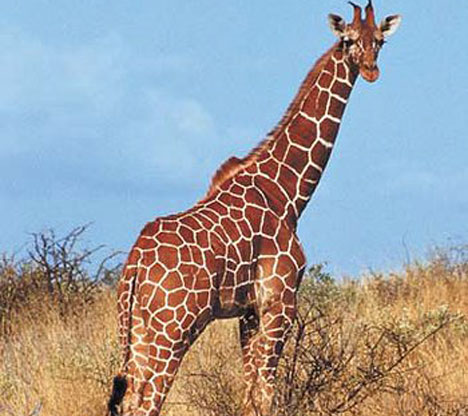Reticulated Giraffe

Spectacularly tall, the giraffe (Giraffa camelopardalis) has a very long neck with a short, upstanding mane, and high shoulders that slope steeply to the hindquarters. The legs are also long. The giraffe’s neck is made up of the same number of neck bones (vertebrae) as most mammals, including humans, but they are much larger and linked by ball and socket joints for improved flexibility.
The specific name of the giraffe comes from the Latin ‘camelopardalis’, meaning ‘camel marked like a leopard’, owing to their buff background with brown blotches, which helps to camouflage them in the dappled light and shade patterns created by the trees they feed on. The various subspecies of giraffe differ slightly in colouration and patterning.
The reticulated giraffe of northeastern Kenya (Giraffa camelopardalis reticulata) has large, chestnut-coloured patches outlined by thin white lines. Rothschild’s giraffe of western Kenya and eastern Uganda (Giraffa camelopardalis rothschildi) has broader dividing white lines than the reticulated giraffe, and no spotting beneath the knees.
The Masai giraffe of Tanzania and southern Kenya (Giraffa camelopardalis tippelskirchi) has irregular star-shaped light to dark brown spots. Giraffes have two horn-like structures about 13 centimetres long made of skin-covered bone; they are thin and tufted in females and thick and bald on top in males, as a result of wearing during fights with other males. Males can develop calcium depositions on their heads in addition to their horns as they age. These help to deliver heavier blows during fights with other males.
